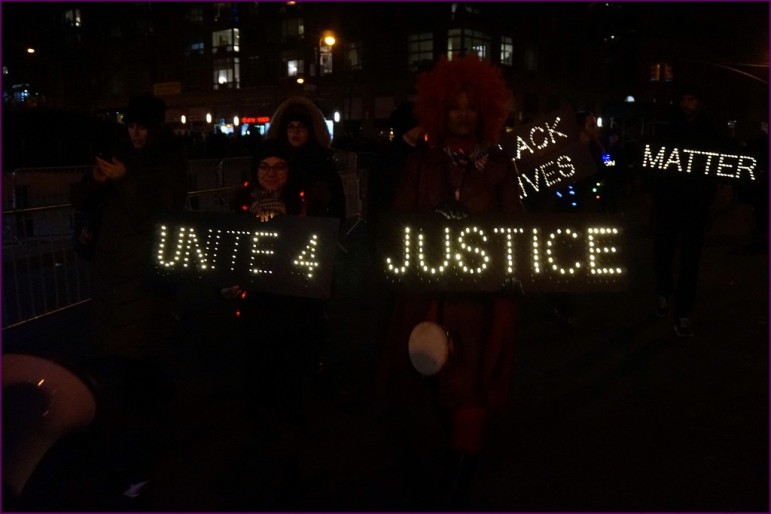
2015 has been, in a word, intense. We have identified nine significant trends and stories to reflect on and encourage you to add a tenth, or as many as you like. We thank all of the readers and others who contributed ideas for this annual column.
- Activism through loose networks continues as a force to be reckoned with…and that’s us
- Nonprofits as political footballs: You’d better learn the game
- Race moves to center stage and refuses to leave quietly: Embrace it
- A qualitative leap in LGBTQ legal and human rights is achieved—what follows?
- The PILOT and property tax issue intensifies: What distinguishes a nonprofit?
- The U.S. social enterprise field remains an overhyped, underfocused, confused mess—take no wooden nickels
- Billionaire-Giver-Hating: Or, valuing democracy above riches
- Many health co-ops fail: What not to do
- Big Philanthropy and the (for now, still) Public Schools
- Activism through Loose Networks Continues as a Force to Be Reckoned with…and That’s Us
In 2011, Time Magazine named “The Protestor” as Person of the Year, and last year “the Ferguson protestor” came in second only to “Ebola Fighters.” When a mainstream magazine comes to understand that it’s not the individual leader that makes a resilient movement, perhaps it is time to acknowledge that there has been a persistence and vitality in collective action over the past decade that speaks to the power of civil society—not embodied in one nonprofit or foundation, or even a single coalition, but in networks of action that have a unified purpose. On the organizational level, we have seen it in stories like Sweet Briar College and the San Diego Opera, and on the state level we have seen it in the widespread pushback to Indiana’s Religious Freedom Restoration Act. On the national level, we have seen consistent action (and some progress) this past year on wages, racial justice, and environmental issues. Take a bow if you participated, but only for a quick moment, because the work is far from done.
- Nonprofits as Political Footballs: You’d Better Learn the Game
Some nonprofits spent 2015 being hauled into the middle of national partisan fights. The most identifiable by name, of course, is Planned Parenthood, which was “stung” by a series of videos released by the Center for Medical Progress in July of this year. Though the footage was later revealed to be rather heavily edited, allegations from the CMP that Planned Parenthood was selling fetal tissue for a profit dogged the organization, which spent the rest of the year fending off attacks made on that basis. The Republican Party and its members made most of the calls to action, threatening to once again shut down the federal government if they could not get a rider defunding the group. (Planned Parenthood, to be clear, has never been federally funded to provide abortions; the funding it receives is for other women’s health services.)
At the time the videos were released, Rick Cohen wrote “Smoke and Mirrors and Malice: What Nonprofits can Learn from the Planned Parenthood Imbroglio,” a critique of the organization’s original communications response.
Nonprofits can take a few lessons from this. First, caution staff against callous discussions of sensitive issues—ever. It is a bad look for any organization dealing with questions of life and death, and a disastrous one when the organization is already in a decades-long war.
Second, when attacked, find a way to use the moment to re-declare your own principles and strengths: “We believe in a women’s right to choose and we admire women who even in their own moment of difficulty can make this decision. We want to be helpful to those good intentions, as any medical facility must, even when a family might be grieving.”
Later in the year, we saw a legislative hearing that was meant to take Planned Parenthood to task for the fetal tissue issue but instead wandered off into other mini-attacks, one of which was an attempt to call out Cecile Rogers, the CEO of Planned Parenthood, for her salary. She was momentarily stymied—probably surprised by the irrelevance of the question—though NPQ later showed that she is relatively underpaid for her position, as many nonprofit women leaders continue to be. Still, it is worth noting that virtually any attack on a nonprofit will eventually include a look at the salaries of its leaders—often available in the public record via the Form 990—and it’s best to be prepared for this cultural prerogative. It is a basic tenet in this sector, which enjoys some reputation for doing good, that excessive greed is not a good look.
As we ended the year, many had moved on to a different vein of extremist rhetoric, aimed at trying to prevent Syrian and Iraqi refugees from entering the United States. While this issue was not identified with any particular organization, in some of the states whose governors had declared them unfriendly to refugees, nonprofit resettlement agencies were threatened with loss of state funding if they were, as is required by their federal contracts, to resettle these refugees. Some groups calmly faced this down, refusing to capitulate while remaining civil. In Texas, this turned into multiple lawsuits brought by the state against both the feds and the resettlement agencies, many of which are national and faith-based. And, indeed, faith communities emerged in force to protect resettlement efforts, as exhibited here and here. This protection from groups other than those involved is critical to the attacked organization’s positioning, and we wish we saw more of it from nonprofits in general.
Other smaller stories from the states included Maine’s Governor LePage threatening to yank funding from a local nonprofit charter school if they went ahead as planned to hire a political rival as president of the school. The school folded in the face of the pressure, but not without reputational losses:
CentralMaine.com reports that alumni and parents feel that the Good Will-Hinckley board’s decision to withdraw a job offer to Mark Eves is a bad example for students indicating that bullying is acceptable and that money trumps values.
Jack Moore, chair of the board, responded in a telephone interview [June 29th] that he just wanted to let the whole situation and that the board made the decision that was in the best interest of the students. “As fiduciaries faced with the loss of state and significant private funding, the very real financial consequences for the school made the board’s unanimous decision on June 24th black and white,” said Moore.
As part of risk management, nonprofits who stand on principle need to be aware that they may be fair game in political infights and that their communications strategies need to be anticipatory of this. In our opinion, central to that strategy should be a repeated restatement of values but do not for a moment think that if you do not live those values that they will be accepted.
- Race Moves to Center Stage and Refuses to Leave Quietly: Embrace It
In Rick Cohen’s predictions for 2015, he wrote:
There will be no hiding place for racism, overt or otherwise. The time for giving racism a pass is drawing to an end. This isn’t a matter of being PC, but a new or renewed commitment of this country toward eradicating the vestiges of official, structural, institutional racism—ranging from the sanctioned, studious ignorance of sports teams to the nation’s failure to indict police for the use of unnecessary, extreme, and often deadly force when not warranted against persons of color—and attacking the roots and persistence of implicit bias. We expect that in 2015, racism will be ratcheted up as a top priority concern for nonprofits.
This has, in fact, played out on many levels. Loose networks like the Black Lives Matter movement have remained active not only in protesting police violence against black people, but in confronting national candidates for government on their attention to race. This confrontation targeted even the most progressive candidates, like Bernie Sanders, which of course shook up the worlds of some lefties, as Cohen relates here:
Some progressives question whether the Black Lives Matter movement has undermined the campaign of the candidate who might be most likely to offer concrete policy responses to the issues they raise. To these critics of the BLM activists, this might be yet another instance of internecine warfare within the left that weakens the candidates the left might otherwise support and hopefully see to victory. Others suggest that it is critically important for BLM activists to shake up the comfortable world of white progressives, including those typically aligned with the Sanders campaign, to make them grasp the seriousness of racial inequities in this country. The #BlackLivesMatter disruptions, in their view, compel politicians like Sanders to address institutional racism in order to adequately respond to the dynamics unleashed after the killing of Michael Brown in Ferguson.
But Sanders responded with a new racial equity platform, which was apparently welcomed by BLM, albeit cautiously:
At this time, #BlackLivesMatter does not endorse any presidential candidate. Moreover, we are not affiliated with a political party. […] As stated in our mission, #BlackLivesMatter is an ideological and political intervention; we are not controlled by the same political machine we are attempting to hold accountable. In the year leading up to the elections, we are committed to holding all candidates for office accountable to the needs and dreams of Black people.
And, indeed, as I write this, yet two more black people are dead from police shootings in Chicago. Neither was in possession of a firearm; one was an emotionally disturbed honor student with a bat in hand, and the other was a woman named Bettie Jones, a member of Action Now Chicago who was, according to witnesses, shot in the neck as she opened the door to police. The Chicago Police Department is currently undergoing a federal civil rights investigation that will look into patterns of racial disparity in the use of force, after the release in November of police dashboard camera video from 2014 showing white officer Jason Van Dyke shooting black 17-year-old Laquan McDonald 16 times. (Action Now Chicago is one of the community organizations calling for Mayor Rahm Emanuel to step down.)
But attention to race has not been confined to this one movement or issue or racial group. A number of studies this year have pointed out persistent diversity problems in the ranks of nonprofits, building more data that confirms the findings of a study released by the Green 2.0 working group which showed that racial diversity among large environmental organizations and their funders was not only low, but lower at leadership levels than at subordinate levels of the organizations. This suggests a kind of ghetto effect. Other studies include one on museums, one on the alternative press, and one on boards of directors and leadership of nonprofits more generally. All exhibit findings that align.
In a country headed toward a non-white majority population, the fact that 90 percent of board chairs and 89 percent of executives (in BoardSource’s sample) are white should be cause for concern. Maybe the terrible persistence of racially based differentials in income, health, and educational statistics would begin to shift more quickly if we insisted on a change in the leadership profiles of our own organizations, and that might be helped by establishing a baseline.
Meanwhile, our most read newswire or article of any kind by far this year was one called “Native Lives Matter: Police Killing Native Americans at Astounding Rate,” and as we ended the year, we were faced with a miasma of the most outlandish hate speech from a front runner in the presidential race. It included as targets Mexicans, disabled people, women, Muslims and more. At one point, we chose to stop covering it because it seemed to be drawing power from the reaction to it, a reaction we and our coverage were a part of. But the dynamic of some significant part of the population tolerating and approving of hate speech while another, growing part demonstrates a real drive for racial justice and human rights is a dichotomy that will likely try to resolve itself in coming months. Do you know how your organization will respond?
- A Qualitative Leap in LGBTQ Legal and Human Rights Is Achieved—What Follows?
In June of this year, after a decades-long struggle by LGBTQ advocates, the Supreme Court ruled in Obergefell v. Hodges that same-sex couples had the constitutional right to marry. This is an amazing step, and can we all just stop for a minute to consider the profound qualitative shift this reflects?
But, although a huge stride forward, the ruling was not a be-all, end-all where the legal rights of LGBTQ people are concerned. NPQ quoted, at that time, John Culhane in a column for Politico discussing the certainty of a backlash and the continued need for vigilance, writing:
In many states, gay and lesbian couples will have great difficulty exercising their newfound marriage rights. In some ways, this new chapter of the gay marriage fight will likely mirror abortion rights in the wake of Roe v. Wade—a right technically legal but frustratingly difficult to exercise in many corners of the country.
So despite the fact that this decision is momentous, all of us who care about civil rights must expect to have to protect and reinforce it with vigilance, whether the pushback comes in in our own neighborhood or a few states over.
But a report suggests that institutional philanthropy’s money does not flow as easily as it once had, and that individual givers are beginning to make up a larger portion of the base. As some may remember, a report for the previous year had shown a substantial increase in philanthropic funding. The Ford Foundation made its withdrawal explicit in a statement about its overall shifts in focus. Darren Walker points to domestic funding of groups working on LGBT issues as an example of important work from which Ford will be pulling back in favor of funding such work outside of the United States. “As a global foundation,” says Walker, “we’re adapting and recalibrating our focus where the greatest need exists.” And on a related front, a small cabal of foundations, including ARCUS, which remains one of the largest funders of LGBTQ causes, have just committed $20 million to pursue the rights of transgender people internationally.
Was it the right time for philanthropy to pull back relative to this movement’s needs? Will individuals step forward to pick up any slack? All that remains to be seen. One thing made evident by the rapid and spontaneous outcry about the Indiana Religious Freedom Restoration Act, however, is that many institutions seem poised to use their financial weight to encourage a legal environment that is healthy for the LGBTQ population.
- The PILOT and Property Tax Issue Intensifies: What Distinguishes a Nonprofit?
In NPQ’s predictions for 2015, we predicted both that municipalities would continue to experience shortfalls and that the issue of PILOTs (payments in lieu of taxes) would become more widespread. We worried that municipalities might begin to tax all nonprofits rather than the very largest. In fact, what we are seeing is that the issue has heated up in the courts and among state regulators in a way that tries to bypass the negotiation of fair payments from universities and hospitals and, in some places, just aims at having them declared less than fully property tax exempt.
This is not an entirely new dynamic, of course—see here and here—but there were some pretty significant cases in 2015, one of which, having to do with the Morristown Medical Center in New Jersey, resulted in a tax law judge declaring the modern nonprofit hospital a “legal fiction.” The town was then able to negotiate a higher payment in lieu of taxes from the institutions with retroactive payments included in the settlement. The same judge, in a subsequent ruling about Princeton University, required Princeton to affirmatively prove just how tax-exempt it was rather than requiring the plaintiff to prove that it was not. Both cases challenged the institutions on the grounds that significant portions of their operations were, in fact, profit-making.
Rob Meiksins points out that an analysis on Law360 shortly after the ruling offered three takeaways: “One is that mixing charity and profit leads to lawsuits. This case is different from most others, where the decisions centered on how much the hospital donated to the local community. In Morristown, the decision was based on the organization’s structure, in which for-profit and nonprofit entities became entangled. A second takeaway is that payments in lieu of taxes, or PILOTs, might offer an alternative. The third takeaway is that legislators will take on tax exemptions.”
And, indeed, that is what is happening in New Jersey, where a standardized approach to taxability and PILOT levels is being pursued by legislators and nonprofit hospitals worried that the court precedent could result in higher negotiated settlements if cases were pursued individually. It is worth noting that at least in the Morristown case, the judge took executive salaries into consideration.
Also this year, NPQ wrote extensively about the fact that the California Franchise Tax Board pulled the tax exemption of Blue Shield of California last August. At that time, Rick Cohen wrote:
Chad Terhune, the L.A. Times reporter on the story, catalogs some of the possible reasons that the Franchise Tax Board might have made this decision. For one, Blue Shield maintains a reserve of $4.2 billion, which Johnson says is four times as much as Blue Shield needs to cover potential future claims. With that kind of reserve, it raises questions as to why Blue Shield sought rate increases recently, even if the company has pledged to hold its “profits” to less than two percent. Another might have been Blue Shield’s high salaries, including paying its former CEO back in 2010 and 2011 $4.6 million a year. Public information isn’t available apparently on Blue Shield’s current salary structure except that it pays a few people over a million each in annual compensation. Terhune also mentions Blue Shield’s past run-ins with state regulators and charges that it hasn’t done well in serving California’s poor.
There is definitely a formula emerging here to determine how a charitable purpose can be measured effectively, and all nonprofits should take note about how it evolves. Note, again, that not only did salaries figure in, but also so did the level of reserves vs. the level of benefit felt by residents, and the state’s poorest residents in particular. The California case has helped to revive such concerns about nonprofit insurers elsewhere.
- The U.S. Social Enterprise Field Remains an Overhyped, Underfocused, Confused Mess—Take No Wooden Nickels
As NPQ has reported time and again, the definitional boundaries of the realm of social enterprise are confused at best. We regret the fact that they are not, in this country, associated as much with worker-owned co-ops as they are elsewhere in the world. Here, the social enterprise scene seems to be more of a Wild West of individual mavericks, with co-ops and other structures for building shared assets largely ignored. This has led to a confusion of endeavors, often loudly and enthusiastically touted, whose outcomes are far from consistently evaluated. And even when they are evaluated, where are the original proponents saying “oops”?
Sign up for our free newsletters
Subscribe to NPQ's newsletters to have our top stories delivered directly to your inbox.
By signing up, you agree to our privacy policy and terms of use, and to receive messages from NPQ and our partners.
Let’s start with the one most often on the minds of those leading nonprofits where the operating margin is unhealthy or where it may be at risk. NPQ has long acknowledged that the existence of related business endeavors has long been a part of the sector’s revenue mix, but when these are mismatched or out of balance with the sponsoring nonprofit, they can be the death of even the largest organizations. This year, we saw the demise of FEGS, the largest social service agency in New York, with an annual budget of $250 million. The failure happened quickly, and some attribute it at least in part to the steady drain on finances that a sponsored and highly touted social enterprise posed.
“As we look back,” we wrote then, “the social enterprise had an accomplice in the hype that had been built around it. Though the enterprise, which was to have provided back-office services to the parent as well as others, appears to have never made any money for the parent organization, it was kept alive for at least 16 years with a lot of attendant publicity about the wonder of it all. In a final ironic twist, it so underperformed in its role that the agency’s rapidly deepening financial crisis was not identified until it was way too late. The quality of its work, however, and its continuing lack of profitability did not stop it from being a finalist for the Social Enterprise Alliance of Long Island’s 2014 Social Entrepreneurism award.”
The real irony was that AllSector, the social enterprise, was meant to provide back office services, but the under-par performance of these services obscured the board’s view of the financial position of the larger agency.
A similar situation was evident in the Center for Building Hope’s acquisition of Brides Against Breast Cancer, an already-failing social enterprise, which similarly drained its parent organization.
More generally, the field appears to be in a deep state of moral and practical ambiguity, as Rick Cohen wrote in “The Murky Progressive Politics in Social Enterprise: Thoughts from Two Conferences.”
Like the specific issue of Walmart’s wage increase, politics makes strange and sometimes uncomfortable bedfellows of the Fourth Sector adherents whose approach to business is to save the planet. In both Case’s comments and a Skype presentation by Sir Ronald Cohen, the famous venture capitalist, Social Impact Bonds were extolled as bringing “rigor and data” to the public sector as an alternative to the propensity of government to “continue to fund programs that cannot and do not show efficacy,” without referencing other significant criticisms of SIBs other than one that Cohen cited, that some people in the UK apparently thought that SIBs could only work when applied to prison recidivism projects. Cohen cited the expansion of SIBs to different kinds of projects and topics generating healthy returns for investors. At a minimum, despite the presence of Rep. John Delaney as a keynoter at the conference, pitching the legislation he has introduced to subsidize the expansion of social impact bonds (which he described as combining “ the best ideas of the progressive movement and the best idea of the conservative movement” as a recipient for “build[ing] bipartisan success”), the jury is still out on whether SIBs bring private sector innovation to the public sector or serve as a new means of funneling tax revenues from the public sector to private corporations and wealthy investors.
Potential difficulties for political progressives buying into the notion of the inherently progressive nature of the Fourth Sector also arise in the sense of who the players might be. Speakers referenced a national commission on how social enterprise can build the middle class, co-chaired by philanthropist Steve Case and former Hewlett Packard CEO Carly Fiorina. […] Fiorina recently denounced social welfare programs as creating a “web of dependence” for people who need help and recently spoke on a CPAC conference panel titled, “Lies Told to You by Liberals,” neither the typical position of progressives. The Case/Fiorina commission’s recommendations included modifying the Community Reinvestment Act to support entrepreneurship, making foundation program related investments more available to entrepreneurs, and establishing a website that through “naming and shaming” would identify and call out government regulations that are seen as unnecessarily burdensome to businesses.
One of the Fiorina/Case recommendations was to provide “entrepreneurial ecosystems-in-a-box” packages for localities that want to encourage social enterprise.
And then there’s the matter of social impact bonds, which may be some of the most highly touted, badly thought through, expensive, and disappointing endeavors we have seen in the past few decades. One article we ran this year focused on what we as nonprofits could learn from the Rikers Island Experiment, and another took on the whole field with a set of pointed questions that get to the essential worth and trade-offs of the method.
The story here is about playing catch-up. The promotion of Pay for Success and Social Impact Bonds ran way ahead of any impartial or detailed scrutiny of how this would actually work. The excitement over the transactions and the disproportionate attention paid to the novelty and financing aspects resulted in little attention being paid to the underlying services that were supposed to produce these results.
- Billionaire-Giver-Hating: Or, Valuing Democracy Above Riches
Plutocracy: an elite or ruling class of people whose power derives from their wealth.
As this year ground to a close, Mark Zuckerberg and Melissa Chan announced they were planning on giving away most of their $46 billion dollar fortune—and by giving away, they meant parking it in an LLC where the general public has no call on the group in terms of transparency or accountability and where they can do good according to their own lights.
It is worth repeating why we think this issue of a new plutocracy is antithetical to our understanding of the core role of the nonprofit sector, which is to provide venues in which people can take collective action for the public good. And so we will repeat here the points we made in a newswire as this year ground to a close:
NPQ used to be the object of much scorn when we stepped out to criticize outsized philanthropic gifts, particularly when they mutated public discourse. Where once we were among a very few voices, now we apparently have more company. We’d like to think the simplest explanation for this is that people are a bit miffed about the vanity playground of charitable gift giving in an economy that is boasting historic wealth divides, and maybe that means they will quit seeing through the obfuscating glow of the halos when a billionaire is trying to remake something to his particular point of view or in his own name.
Of course, there have always been some love/hate sentiments about philanthropy, especially in the midst of an unbalanced economy. “We’ve always had this very mixed attitude toward very wealthy people giving their money away,” said Leslie Lenkowsky, an Indiana University professor of philanthropy. “It’s a long, drawn-out controversy. Our concerns about equality and inequality are bringing it back to the surface today.”
[…]
Not for nothing, but this kind of money also buys outsized influence just about anywhere they want to take their philanthropic dollars—including in public systems that are supposed to be governed democratically. [ProPublica’s Jesse] Eisinger writes that “instead of lavishing praise on Zuckerberg for having issued a news release with a promise,” we should be considering what kind of society we want to live in and if we want one rich young man substituting his decisions for those of elected officials who, in theory, could be held accountable to the public.
And that is the question we want to leave you with.
- Many Health Co-ops Fail: What Not to Do
NPQ has, from time to time, covered the fate of organizations or initiatives seeded and essentially started primarily by their funders instead of as bottom-up efforts to address a problem. In the latter case, you might enjoy a strong anticipatory advocacy environment, but too often, in the former cases, the organizations remain relatively frail and dependent on external decision-making.
In October of 2014, NPQ’s Rick Cohen did a review of the nearly two dozen new nonprofit health co-ops established under the Affordable Care Act, laying out not only the challenges in front of them but their strong adaptive capacity in entering a highly competitive market. The co-ops were to have stood in for a single-payer system, or a “public option,” a critical function, but by mid-October of 2015, eight of them had failed. Among them were the Health Republic Insurance Company in New York and the Kentucky Health Cooperative. The latter is a little shocking, since the Kentucky Co-op had outperformed its rivals on the Kentucky exchange and enrolled 51,000 members. Other shutdowns included the Louisiana Health Cooperative, Nevada Health Co-op, and CoOportunity Health, the latter covering Iowa and Nebraska, as well as Tennessee’s Community Health Alliance.
Health Republic Insurance in Oregon voluntarily decided “to refrain from entering the market in 2016 and begin an orderly wind down of business” as a result of the federal announcement to limit Risk Corridor Payments to 12.6 percent of what the CO-OPs had anticipated. Colorado’s shutdown was ordered by the state Division of Insurance and protested vociferously by Julia Hutchins, the CEO of Colorado HealthOP. “We are astonished and disappointed by the Colorado Division of Insurance’s decision,” Hutchins said in a statement. “It is both irresponsible and premature.”
The National Alliance of State Health Care CO-OPs issued a statement that placed responsibility for the wave of closures on the federal government:
The dissolution of [three] CO-OPs this week is a devastating blow to Americans who seek competition, choice, innovative benefits, and non-profit alternatives when selecting a health insurer. It is no coincidence these announcements come on the heels of the recent notice by CMS that only 12.6 percent of the 2014 risk corridor will be paid to insurers. Many of the CO-OPs now closing were well on their way to longer-term financial sustainability, but few businesses can sustain hits like the CO-OPs and other small and new insurance companies have endured from unexpected risk adjustment obligations and much lower-than-promised risk corridor payments.
Cohen summed up the situation, including the silence of sector leadership, as follows:
“In other words, the nonprofit health insurance CO-OPs were brought into existence to do more than test the idea of seeing what a dozen nonprofit ventures might do in the health insurance field. The CO-OPs were created under the Affordable Care Act in the absence of a “public option,” much less a single-payer system, to provide price and product competition to the oligopolistic big corporations that dominated the health insurance markets across the nation. As a matter of the policy objectives of the Affordable Care Act, the federal government should have been looking at all reasonable means for sustaining the CO-OPs through their early years in order to challenge the dominance, the high costs, and the inadequate consumer care that the big corporate insurers were known for.
“Despite a number of regulatory hurdles aimed at constraining the operational flexibility of the CO-OPs, the CO-OPs used their nonprofit ingenuity for reaching out to potential enrollees, building alliances with other nonprofits, overcoming restrictions on marketing by engaging in public education about health insurance and healthcare, and succeeding in many cases with enrollments beyond expectations—and despite dysfunctional state health exchanges. The CMS decision on the risk corridor payments pulls the rug out not only from the CO-OPs as organizations, but from the federal policy commitment in the ACA to resist and overcome the dominance of the likes of Aetna, Anthem, Cigna, and Humana.
“It is truly embarrassing that nonprofit leadership organizations have taken the opportunity to say absolutely nothing about the unfair treatment of nonprofit health insurance CO-OPs.”
- Big Philanthropy and the (for now, still) Public Schools
Philanthropic intervention in public school systems has now become a mainstay of plutocratic philanthropy. Let’s face it; it is hard to have any real influence in the schools any more without a donation in the range of eight or nine figures. Such investments are increasingly common, but there is a quid pro quo in the money-for-influence category, and if the rich person happens to be a bit off-track, you can end up not just with wasted philanthropic resources, but wasted public resources and disenfranchised stakeholders. Never mind the children.
This is a trend that started three decades ago, with the Annenberg Challenge which harnessed about $1 billion for education improvement in Chicago. Now big dollar investments are aimed at increasing “school choice,” which very often translates to expanding charter schools, the outcomes of which are still very mixed, as Rick Cohen reported here. But this year we have seen some major developments in that area. One of the most notable was in the L.A. United School District (LAUSD), one of the largest school systems in the nation, where billionaire Eli Broad is offering a half-billion-dollar investment (give or take $10 or $40 million) to back a controversial plan to expand the role of charter schools in the system. The proposal has caused real polarization among parents and other stakeholders and has in general been so heavy-handed that three other local foundations came together to make a statement decrying the lack of attention to including stakeholders in such planning. The school board declared itself opposed, and the departing L.A. school chief, Ramon C. Cortines, spoke out only on the eve of his departure, calling Broad’s controversial proposal “ill advised.”
So, on the one hand, doubtful public officials; on the other, half a billion dollars.
The outcome is yet to be known. But some big philanthropic investors in our public schools have also acknowledged there is a problem, as Valerie Strauss of the Washington Post points out in the case of the Walton Foundation. The Waltons favor school choice, including charter schools, and they also have a big footprint, having poured some $1.3 billion into K-12 education over the last twenty years.
Strauss points to a recent publication emanating from on high, titled, “Investing in Change: The Walton Family Foundation Charts a New Course.” The report notes:
One area where the foundation has received criticism is in the area of community engagement. It has been accused of having a top-down approach that does not adequately address the needs and desires of parents, local advocacy groups and community groups. This is an issue the foundation is grappling with. “The provision of choice, and the publication of data on school performance, has sometimes had little impact, especially in districts where reform lacks adequate local ownership, community and wider civic involvement, and parent engagement,” Bruno Manno notes. He identifies two levers in engaging local partners and communities more thoroughly: 1) building an active coalition of supporters, and 2) cultivating local advocacy partners. “We need a local and civic base of support for the work that’s going on. The work we support requires a stable constituency to be advocates for schools over time. There is a political dimension as well, the community and families need to understand what options are available.”
Strauss writes:
Let’s review: After 20 years, the foundation realizes that its top-down approach doesn’t adequately address the needs and desires of parents, local advocacy groups and community groups. Now it wants to engage local partners and communities—not, apparently to ask what they actually want in their communities but to build “a local and civic base of support for the work that’s going on.”
This hijacking of public systems is just plain dangerous and it poses the far end of the problem with high dollar, top down philanthropy. The philanthropist can walk away from the consequences of any mistakes, but the systems and the children and their parents may suffer consequences for many years to come.
Conclusion
Are these truly the most important stories of 2015? We welcome reader submissions of stories they see as vital to the sector as a whole. We will add them to this piece as addenda.













